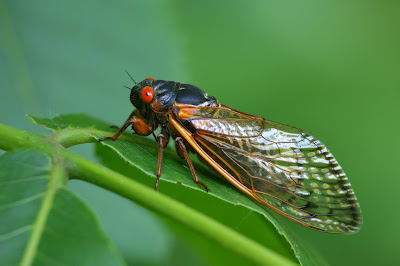17 things to know about the 17-year cicada invasion
 |
| Soon our yards will be full of cicadas like this one. [Scientific American] |
As we’re nearing the end of one plague, we’re about to be inundated by another. Billions of cicadas in Brood X, hidden underground for the past 17 years, will emerge across parts of the East Coast and Midwest in May. The D.C. region is expected to be the epicenter.
We’re certainly not comparing the cicada invasion with COVID, which so far claimed the lives of more than 2.8 million people worldwide.
The plague of cicadas is merely annoying. There are so many, they make a mess on windshields, clog pool filters, and get in people’s hair and clothing. They make a deafening roar when mating, and the exoskeletons they leave behind crunch underfoot.
Brood X is already being felt, if not quite seen yet; raccoons and other animals are digging holes in yards throughout Northern Virginia looking for the cicadas as they start to make their way out of the soil.
According to Cicadia Mania, here are 17 facts the insect invasion:
1. Cicadas will start to emerge from a hole about the size of a dime when the soil temperature warms to about 64 degrees Fahrenheit. They usually come out of the ground at night or during the early morning.
2. When the cicadas emerge, they start climbing anything tall, even a building if there isn’t a tree nearby. Their goal is to find a mate and lay eggs.
 |
| Cicada nymphs [Prof. M.J. Raupp/Bug of the Week] |
3. A typical cicada emergence follows this schedule: March 14-May 2 – animals dig for cicadas; April 11-May 2 – holes and chimneys appear; May 9-May 23 – nymphs emerge and molt; May 9-June 20 – Male cicadas sing; May 23-June 13 – chorusing, wing flicking, mating, and egg laying; May 9-June 20 – cicadas die off, either from predators or fatigue; June 6-Aug. 15 – flagging of trees; July 25- Aug. 15 – eggs hatch.
4. The exact dates of the cicada lifecycle will depend on the weather. Hot weather means an early start and a shorter season. Cool weather means a later start and a protracted season.
5. Male cicadas sing to attract females. They make a noise measured as loud as 90 decibels with drum-like structures on their abdomens called timbals. Females make a sound with their wings.
6. Cicadas are attracted to lawnmowers and power tools. It’s best to do lawn work before 10 a.m. and after 5 p.m. when cicadas are less active.
7. The eggs hatch about six weeks after mating. The baby cicadas look like tiny termites. They eat tree sap, then fall to the ground, and burrow a tunnel where they live for the next 17 years. They spend their time underground feeding and tunneling – not sleeping.
8. Cicadas have five eyes, including two big red compound ones and three simple eyes on the top of their heads that are believed to detect light and darkness.
 |
| Cicadas mating |
9. Cicadas are harmless to humans. They do not bite or sting.
10. They do pose a concern for trees. Female cicadas lay their eggs in live twigs. These affected branches will likely fall to the ground, allowing the newly hatched cicada, or nymph, to again burrow into the soil. Trees can tolerate this pretty well, but the sheer number of insects laying eggs may result in some twig dieback, especially on younger trees.
11. Residents should delay planting new trees until the fall. It’s also advisable to protect young trees by placing netting that is 3/8 inch or smaller around the crown.
12. Brood X includes three species: Magicicada septendecim (broad orange stripes with more orange than black on their abdomens), Magicicada cassini (black abdomens with no orange), and Magicicada septendecula (stripes are more black than orange).
13. Why 17 years? There are also 13-year cicadas, and scientists speculate a life cycle based on a relatively large prime number makes it difficult for predators to synchronize with them. Annual cicadas are eaten by wasps that have evolved to prey on them.
14. It’s rare to have the 17-year and 13-year broods emerge at the same time. The next time that happens will be 2115.
15. Wear a hat outdoors. Cicadas eat tree sap and could pee on your head. Their urine is called honey dew or cicada rain.
16. Cicadas are edible. Birds will feast on them. Dogs eat them but make sure they don’t overdo it, as they can get sick or choke.
17. For humans, cicadas are best enjoyed when they first emerge and have a soft, white exoskeleton. They can be fried in butter and garlic, barbecued, and used as a pizza topping. They are a good protein source but are high in mercury, so eating them is not recommended. People who have tried them said they taste like asparagus or like cardboard with a piney scent, like those car fresheners that hang from the rear-view mirror.

.17 makes me think it is already April fools day! Yum!!